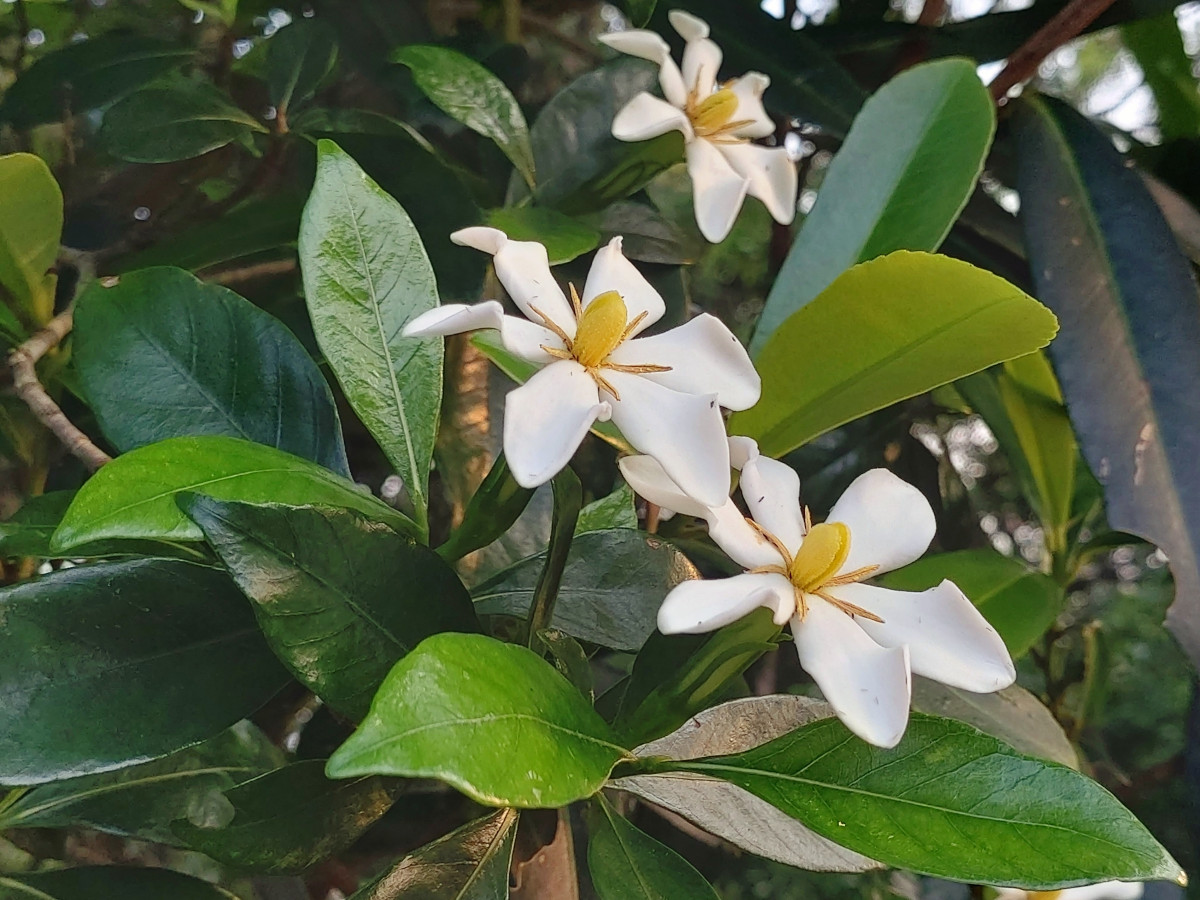Gardenia jasminoides J.Ellis - Rubiaceae - 栀子 zhi zi (chin.), common gardenia, cape jasmine, Gardenie, Knopflochblume
Evergreen shrub, up to 3m tall, native to China, Vietnam, Taiwan and Japan; flowers white to pale yellow.
var. fortuneana: corolla doubled; flowers sterile, plants not setting fruit; cultivated plants.
var. jasminoides: corolla simple; flowers fertile, plants setting fruit; wild and occasionally cultivated plants.
http://www.efloras.org/florataxon.aspx?flora_id=2&taxon_id=200022091
„With its shiny green leaves and heavily fragrant white summer flowers, it is widely used in gardens in warm temperate and subtropical climates, and as a houseplant in temperate regions.“ wikipedia
„The gardenia absolute was separated into basic, phenolic, acidic, lactonic and neutral fractions and analysed by using GC, combined GC-MS, IR and NMR. A total of 130 components was identified… interesting constituents contributing to the characteristic floral sweet-green odor of this flower were lilac aldehydes, lilac alcohols, cis-3-hexenol and its esters, esters of cis-3-hexenoic acid, esters of tiglic acid and jasmine lactone… Jasmin lactone (5-hydroxy-cis-7-decenoic acid lactone…) was the most important constituent responsible for the sweet odor of this flower. This lactone was first found in the jasmin absolute and more recently in black tea as a characteristic constituent. As well-known, jasmin lactone has an odor rich in floral sweetness which is responsible for a jasmin aroma. According to our study of the jasmin absolute, the amount of this lactone was generally less than 1%. It was rather interesting that the Ooyae-kuchinashi absolute contained 8% jasmin lactone… In conclusion, the attractive sweet-green odor of this flower originates from an excellent harmony of these components identified in this work, especially cis-3-hexenol and its esters,
esters of cis-3-hexenoic acid and tiglic acid, and jasmin lactone.“
[Chemical composition of the absolute from gardenia flower., Hattori, R., Muraki, S., Yoshida, T., Agricultural and Biological Chemistry, Vol.42(7), 1978, 1351-1356]
Of the more than 200 compounds found in the absolute, more than 100 could be identified by GC/MS. Olfactory valuable compounds found with a concentration higher than 1% were: linalool (2.1%), benzyl phenylacetate (1.7%), methyl phenylacetate (1.4%), phenylacetic acid (1.3%), 1-phenylethyl acetate (1.2%), myristic acid (1.2%), benzyl benzoate (1.1%), geranyl acetone (1.1%), (Z)-3-hexenoic acid (1.1%), 2-methyl butyric acid (1.1%), benzyl acetate (1.1%), valeric acid (1.0%), p-cresyl acetate (1.0%), ethyl phenylacetate (1.0%), 2-phenyl ethylacetate (1.0%), methyl anthranilate (1.0%), (Z)-4-heptenol (1.0%) and valeraldehyde (1.0%).
[Volatiles of the Absolute of Gardenia jasminoides Ellis (Rubiaceae), Gerhard Buchbauer , Leopold Jirovetz , Alexej Nikiforov , Vijay K. Kaul and Norbert Winker, Journal of Essential Oil Research, Vol.8(3), 1996, 241- 245]
Regarding enantiomeric ratios of volatiles from Gardenia jasminoides flowers, their headspace contained (R)-(-)-linalool (16,1%; 97.9%ee), (S)-(-)-γ-hexalactone (0.3%; 96.3%ee), (E)-(+)-nerolidol (0.1%; 92.9%ee), (R)-(+)-γ-decalactone (0.1%; 95.0%ee), and (S)-(+)-δ-jasmine lactone (5.4%; 99.0%ee).
[Analysis of enantiomeric ratios of aroma components in several flowers using a Chiramix column., Tamogami, S., Awano, K.I., Amaike, M., Takagi, Y., Kitahara, T., Flavour and fragrance journal, 19(1), 1-5, 2004]
Headspace-SPME-GC-MS: Main volatile compounds emitted by fresh flowers and collected on PDMS/DVB fiber were linalool (38.2%), farnesene (21.4%), (Z)-3-hexenyl tiglate (16.2%), (E)-β-ocimene (19.5%), methyl tiglate (4.3%), hexyl tiglate (3.9%), and caryophyllene (2.8%). Interesting minor components of the flower scent were (Z)-3-hexenol, (Z)-3-hexenyl acetate, (Z)-3-hexenyl propionate, (Z)-3-hexenyl butyrate, methyl salicylate, (Z)-3-hexenyl 2-methylbutyrate, indole, isoeugenol, and (Z)-3-hexenyl benzoate.
[Chaichana, Jarubol, et al. „Volatile constituents and biological activities of Gardenia jasminoides.“ J Health Res 23.3 (2009): 141-5] PDF
Essential oil obtained by steam distillation of flowers from Niger delta contained mainly α-farnesene (28%), linalool (22%), (E)-β-ocimene (10%), α-terpineol (9%), guaiol (5%), (Z)-3-hexenyl tiglate (5%), bulnesol (5%), tetracosane (5%), (Z)-3-hexenyl benzoate (4%) and methyl tiglate (2%).
[Composition of Essential Oil of Nigerian (Niger Delta) Grown Gardenia Jasminoeide Flower. Gloria Ukalina Obuzor, Matthew Ifechukwude Nwaokolo, International Archive of Applied Sciences and Technology, Vol 1 [2] December 2010: 32 - 36] PDF
An absolute from enfleurage of Gardenia jasminoides flowers (pale liquid with fresh gardenia odor) contained (Z)-β-ocimene, indole, (Z)-3-hexenyl tiglate, (Z)-3-hexenyl benzoate, and (E)-9-octadecene.
[Volatile profile and sensory property of Gardenia jasminoides aroma extracts., Kanlayavattanakul, M., Lourith, N., Journal of cosmetic science, 66(6), 2014, 371-377]

var.fortuneana as Gardenia radicans Thunb., Botanical Register, vol.1 t.73 (1815) [S.Edwards]
plantgenera.org

Gardenia jasminoides var.jasminoides, Taipei, Taiwan (2025) © 黃秋菊 CC BY-SA 4.0 inaturalist.org